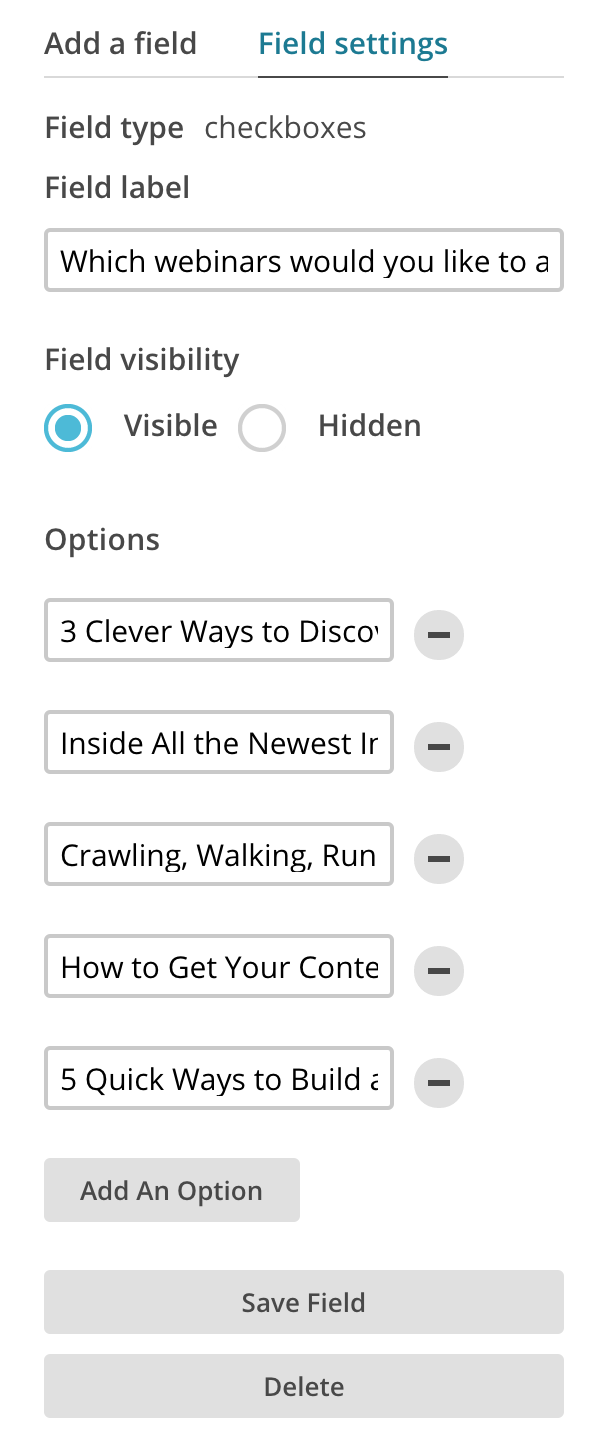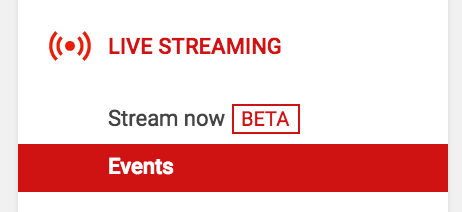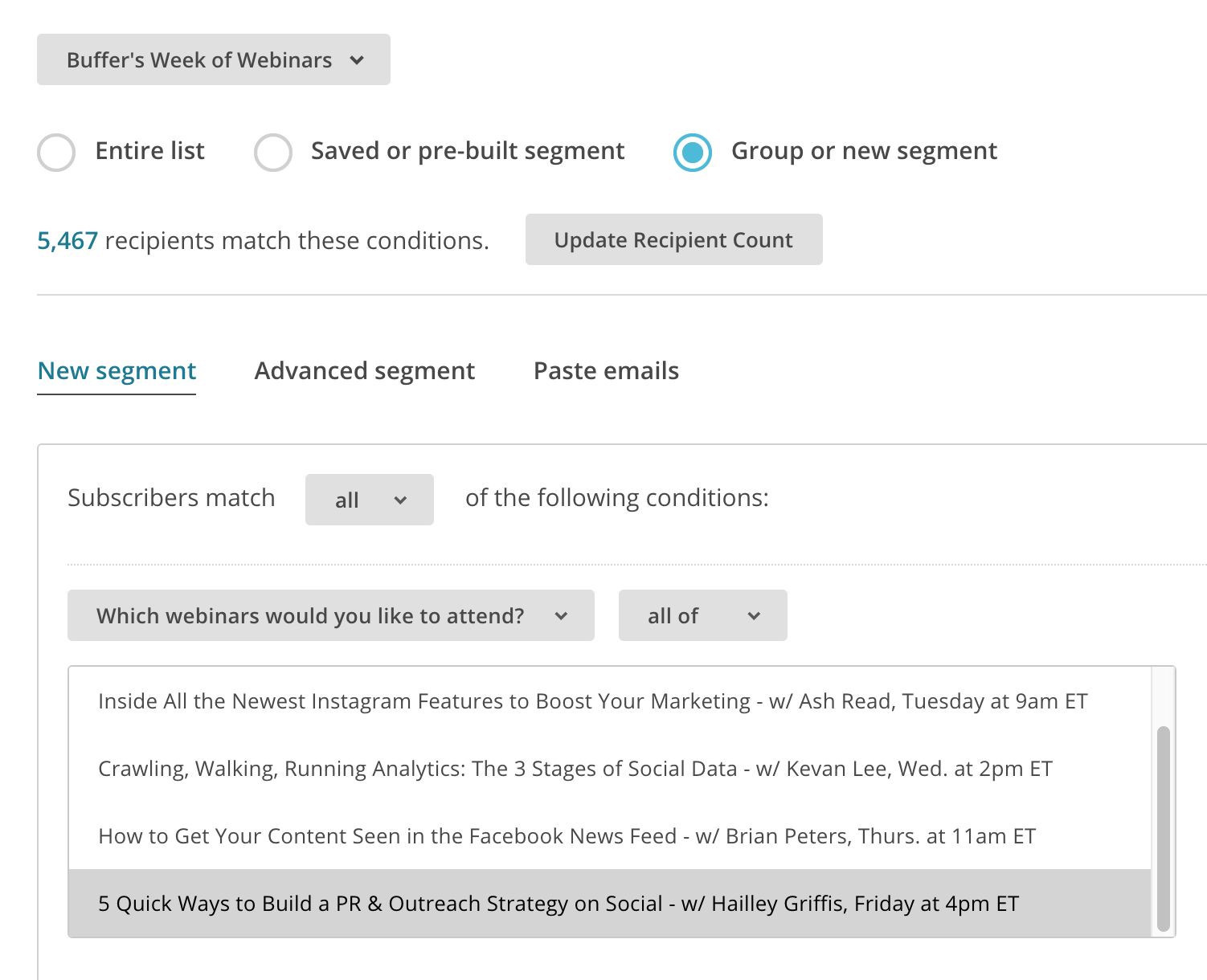Key Stats
Buffer signups
12,422 +25.7%
Buffer for Business trials
1,034 -13.7%
Social blog sessions
1,227,494 -2.7%
Email subscribers
97,205 -3.6%
NPS
56 -1.7%
Last summer, in a tiny Icelandic coworking space on a Buffer team retreat, we recorded the very first episodes of the Buffer marketing podcast.
More than a year later and sans those initial episodes, the podcast is here!
Yes, those first episodes didn’t make the cut and neither did several other attempts that followed. The Buffer marketing podcast was a long-wished-for project that simply needed the right timing: people, talent, ideas, knowledge. If you’ve ever wanted to start a podcast — if you’ve ever wished to do anything ambitious or new — you might’ve found similar serendipity blocks. I’m happy to encourage that you can do it, and I’m happy to share how we did.
Read below to learn how The Science of Social Media, our new podcast, finally came together, and get more info on how September unfolded for us on the marketing team. I’m excited to share everything. Hope you enjoy! Feel free to AMA (ask me anything) in the comments.
We launched a podcast! (After 23 important steps)
Podcasting might be one of the most powerful channels for building brand authority. At least, that’s what we’re hoping to test out!
It took us over a year since we started our podcast explorations to finally come through and ship the podcast. There were likely a number of reasons why, including this one:
The ROI of a podcast is murkier than most every other piece of content.
You can track a blog reader’s journey through your marketing funnel. You can put UTMs on your email links.
But a podcast?
Guesses and wishes.
We truly believe that podcasting works as a significant medium for boosting your brand. We just didn’t know how to prioritize it. In the absence of data, we defaulted to the marketing efforts that we could do most efficiently with the small team that we had, and those efforts meant blogging, PR, social, and community.
Then a few things happened:
- Courtney launched a culture podcast, which proved to be awesome inspiration and a wonderful resource to learn from.
- Our team got bigger. In the past 12 months, we’ve added Ash, Hailley, and Brian, plus we merged with the community team and brought in a data analyst (David) and an engineer (Steve).
- Podcasting really took off as a marketing channel.
I like to think that timing isn’t a determining factor in the projects we choose for marketing. Though in this case, it sure seemed that providence was waiting for these pieces to come together before a podcast could work.
In having Courtney take the first steps with the CultureLab podcast, we were able to remove the element of the Big Unknown from our podcasting efforts. She had done it. It was possible!
Moreso, we had an incredible resource to lean on who could tell us exactly what it was like to launch a podcast from scratch.
In terms of the actual people we needed to pull this off, in the past we found that the level of attention and care needed to do a podcast in the way we envisioned was a bit beyond our means (there were just the two of us, me and Courtney, working on marketing at the time). Enter Brian and Hailley, who graciously offered their time and energy to interview guests, edit the audio, research and brainstorm on all things podcasts, and create a really amazing podcast experience.
And the final bit of impetus: Podcasting continued to grow! We couldn’t really ignore it any longer as a channel to experiment with.
All these factors helped us get over the hump with podcasting and to actually ship the show. You can have a listen to all the episodes so far; feedback has been very kind and affirming. We’re nearing 35,000 total listens through the first three weeks!
The 23 things we did to launch
In terms of what specifically it took to launch a podcast, here’s a quick rundown of everything we thought about before launching:
- Choose a subject (social media)
- Come up with an original idea (telling the stories of individual marketers doing great things on social media)
- Choose a format (interviews)
- Choose a length (30 minutes or less)
- Choose a name (The Science of Social Media) (this took a reallllllly long time to settle on)
- Find or create intro music (we created it)
- Detail out the particulars of the format (example here)
- Figure out what software and tools you need (for us: Skype, Skype Recorder, Adobe Audition, Libsyn, Soundcloud)
- Order equipment (for us: Yeti microphones and pop filters)
- Reach out to guests
- Coordinate recording times
- Interview guests
- Build a podcast landing page
- Make the podcast logo artwork
- Record the intro/outro
- Mix, balance, and edit the final audio
- Write the show notes
- Transcribe the audio (we haven’t done this just yet, but we would’ve gone with Rev if we had)
- Upload to Libsyn
- Submit to iTunes
Once we had all this in place, then we could launch!
And once we had the launch completed, then there was promotion. Almost forgot! It ended up that the promotion element was (and still is) an area with almost as much to do as getting the podcast launched in the first place. Here’s an article with all the research we did and the strategies we’re trying:
We Didn’t Know How to Promote a Podcast. So Here’s All We Learned
I’d love to hear what your experience is with starting a podcast … or thinking of starting one! Let me know any questions you have or any advice/feedback you’d be open to sharing. It’d be great to empathize together!
September’s highlights from Buffer marketing
1. Week of webinars – here’s how to do it super lean
One of our Q3 OKRs was to get a lot of people onto a Buffer webinar.
And three-quarters of the way through the quarter, I had really dropped the ball. We had hosted zero marketing webinars.
In the back of my mind, I had been holding onto the idea of running a series of webinars one after the other in a really short timeframe. I thought that we could whip something like that up quite quickly, which was probably why I had procrastinated so long. Soon enough, the time came to follow through on that hopeful prediction!
In the span of 10 days, here’s how we went from zero marketing webinars to five marketing webinars and a reach of 6,395 people.
Day 1:
Late on Wednesday, we found out that a marketing email to all our Buffer customers (a list of 1.5 million) was looking iffy. The intended topic, a product launch, was unlikely to happen.
Thinking quickly, Hailley and I jumped into the draft to quickly put together an email about webinars. Here’re the steps we took:
- Wrote the email copy, leaving a placeholder to describe the topics for all five webinars. Reached out to the happiness team to share the content of the email.
- Hopped into Slack to check with the team about who wanted to run a webinar next week and on what topic.
- Filled in the email with the new topics.
- Jumped into MailChimp and created a new email list. On the General Forms tab, we added an extra field to the signup form for people to select which webinars they wished to attend.

This MailChimp form became the landing page for our webinars. We added this page to the email and linked to it in all of our webinar promotion materials.

Day 2:
We sent the email!
The response was really great, and the MailChimp form worked smoothly with no hiccups. The nicest part was that all the details for the webinar registration was handled automatically in MailChimp. I customized the wording of some of the follow-up emails, but mostly I stayed hands-off and let MailChimp do its thing.
With this part of the plan complete, I turned my attention to finding a webinar software program to use. There are a lot of great ones to consider like GoToMeeting, Zoom, and others. For us, it was important that
- The software was cheap or free.
- The software was easy to setup and learn. (We had three days to all feel fully comfortable with whatever we chose.)
- You could do screen sharing.
- The software could handle thousands of viewers at once. Soon after sending the email, we were already seeing hundreds of signups.
- The webinar itself is easy for people to attend and rewatch
We ended up going with YouTube Live, which was great for all the reasons we wanted:
- It was free
- The software is built on Google Hangouts, which we were quite familiar with
- We could do screen sharing
- The video is live on YouTube, for as many people as you want
- The video is live on YouTube, accessible before, during, and after from a single link
Day 3:
I went in and set up all the webinars for the coming week by creating new events from the YouTube Creator Studio. All the live sessions are available in Creator Studio by clicking on Live Streaming > Events from the left-hand menu.

In terms of setup, all I needed to do here was to give the event a name, description, and tags, then be sure that the Type was set to “Quick (using Google Hangouts on Air).”
After setting up the videos, I returned to MailChimp to email out the links to the webinar sessions as well as calendar invites for everyone. We went with a pretty simple format for emailing:
- 1 email reminder 24 hours beforehand
- 1 email reminder 30 minutes beforehand
- 1 email followup shortly after the webinar concludes
I created these for each of the webinars and scheduled them in MailChimp. To make sure I was sending email to only those who registered for each specific webinar, I created a new segment according to the webinar signup field.

Note: I was a bit lost as to how to quickly create calendar reminders for every webinar and for every calendar program (iCal, Outlook, Google Calendar). Fortunately I came across Add To Calendar, an easy tool that creates the links for you.
Days 4 and 5: The weekend!
Days 6 thru 10: The webinars
Come Monday, we started hopping onto the webinars. Each one went very smooth, and we were delighted to see how much chatter there was among participants in the YouTube chat box (a fun feature that we didn’t anticipate at all).
And there really wasn’t too much more work to do, other than send out a replay of the webinar to all registrants afterward. Since the link was the same for before, during, and after, there was little effort on my side to need to hunt down anything further.
Now all the content from these webinars remains online, for all to see. You can check out any of the videos below:
Here are the numbers from each of the webinars:
- 3 Clever Ways to Discover and Share the Very Best Content on Social Media: Attended – 1,205, Total views since – 2,685
- Inside All the Newest Instagram Features to Boost Your Marketing: Attended – 785, Total views since – 1,633
- Crawling, Walking, Running Analytics: The 3 Stages of Social Media Data: Attended – 728, Total views since – 1,150
- How to get your content seen in the Facebook News Feed: Attended – 711, Total views since – 1,367
- 5 Quick Ways to Build a Far-Reaching PR & Outreach Strategy on Social: Attended – 349, Total views since – 964
2. Sharing our OKR results for Q3 (and looking ahead to Q4)
These past few days at Buffer have been a really fun exercise in reflecting back on all that we accomplished in quarter three of the year (July through September) and looking ahead to what we want to achieve together in quarter four (October through November).
I’d love to share with you how exactly we did over the previous 90 days on all the goals we set.
(OKRs stand for “Objectives and Key Results.” We set 3-5 objectives (goals) for the quarter and then quantify those with 3-5 key results (targets) for each objective.)
Here is what we set out to do in Q3:
Make a significant impact on Buffer’s MRR and revenue growth (Score = [0.8 out of 1.0])
- Get 3,000 Buffer trial starts by end of Q3 [1.0]
- Grow the Social blog to 1.3M sessions per month by end of Sept [0.8]
- Pablo > Buffer trial starts to 20/day [0.4]
- Communicate with Buffer user list at least every 3 weeks [1.0]
Expand Buffer’s reach by helping new audiences get to know Buffer [0.5]
- Get 8,000 people registered for a Buffer webinar, 4,000 of whom are new to Buffer [0.9]
- Generate 125,000 views on 2 pieces of co-promoted content [0.4]
- Hold 3 local events to attract 600 people who are new to Buffer [0.0]
- Submit a detailed proposal for Buffer conference w/ research and costs by August 31 [0.5]
- Get 100,000 listens to a social media podcast with 4 weeks of launch [0.8]
Innovate! Set a new standard for experimentation and thought leadership w/ Buffer marketing [1.0]
- Create 3 videos per week to use on social media, blog [1.0]
- Ship 1 engineering-as-marketing product [1.0]
- Meet weekly as a marketing team to brainstorm and share new ideas [1.0]
- Hire/work with: 1 marketing engineer and 1 designer [0.8]
- Track NPS score in a daily dashboard and perform NPS cohort analysis for possible Q4 focus [1.0]
—
And here’s what we’re looking to do in Q4:
Improve signup numbers, build a rock solid funnel
- Drive 33,000 Buffer signups from marketing by end of Q4
- Get 3,500 Buffer trial starts from marketing by end of Q4 and increase conversion rate to 13%
- Finish buyer persona research by October 31
- Build a custom signup flow (landing page, funnel) for each persona by November 30
- Create new Looker dashboards for personas/channels, and integrate in Slack for greater visibility and awareness
- Improve landing page conversion by 5%
Provide educational resources to as many people as we can
- Hit traffic goals on Social blog of 1.4M in October, 1.3M in November, 1.1M in December
- Host 10 live events online or IRL w/ 20,000 total participants
- Average 5,000 listens per podcast episode by end of Q4
- Reach 5,000 live viewers and 25,000 plays to Buffer live video (Facebook, YouTube, etc)
- Share Buffer educational materials via 3 new networks/channels by end of Q4 (SkillShare, Teachery, General Assembly, microsite, etc)
Make sure the Buffer product is the very best it can be
- Audit current NPS implementation. Set a new baseline by Nov 15 and a target goal for Q1 2017. Analyze Promoter/Detractor comments.
- Hold a marketing sync with the product team every two weeks; take notes and share afterward
- Send 3 big emails to Buffer customers about product-specific enhancements or improvements
- Ship 1 new engineering-as-marketing product
What are you working on over the next month or quarter? It’d be awesome to hear your ideas!
What can we share that would be helpful for you?
If you have any questions at all about our marketing plans or projects, I’d be so happy to chat with you here in the comments. Feel free to share any thoughts or questions, and I’ll jump right in!
Check out other reports from September:
Try Buffer for free
140,000+ small businesses like yours use Buffer to build their brand on social media every month
Get started nowRelated Articles

Note: This is the quarterly update sent to Buffer shareholders, with a bit of added information for context. We share these updates transparently as a part of our ‘default to transparency ’ value. See all of our revenue on our public revenue dashboard and see all of our reports and updates here . It's been quite the y

Editor’s Note: Thanks for checking out this post! We’ve released our updated 2021 pay analysis here. You can’t improve something if you don’t know that it needs to be improved. That was very true for us four years ago when we first started looking into equal pay at Buffer. We have long used a salary formula to determine all of our salaries – the same role in the same part of the world receives the same salary. That m

Ever since the world got turned upside down by COVID-19, it’s been “business as unusual” for everyone – Buffer included. I sent this update out to Buffer’s investors one week ago. I hesitated on whether to share it more widely, as I know a lot of companies have been impacted more severely in these times. That said, I believe it makes sense to lean into our company value of transparency, since there may be some companies this could help, and it shows Buffer customers that we will be around beyon

